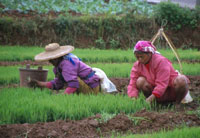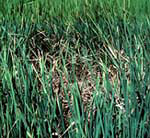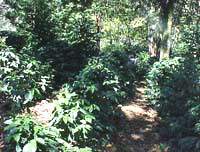
Rice as rice can be.
In the humid hills of China’s Yunnan province, rice farmers make their living from plots of land smaller than many American yards. High, cool, and wet, the country here is rich, yielding almost a thousand pounds of rice per acre. But farmers face a perennial scourge: rice blast.
Rice blast is caused by a fungus that cuts off nutrients to the rice seed head and destroys crops. It thrives in rice monocultures and particularly favors the short-grained, or sticky, strains of rice that bring the highest price at Yunnan’s markets. By 1998, many farmers had given up growing sticky rice altogether, even though there was significant market demand. That’s when researchers from Yunnan Agricultural University in Kunming began attending village meetings in Jianshu and Shiping counties. They explained how a local farmer had almost no rice blast when he mixed his crops, planting rows of sticky rice between rows of long-grain rice. Although monocultures were susceptible to the blast, mixed plantings seemed to resist it.

Oh, blast! The fungus leaves
its mark in a paddy.
Photo: University of California
at Davis.
That year, hundreds of other farmers adopted the technique, planting 1,800 acres in mixed rows. Sticky rice yields per acre skyrocketed, jumping 89 percent, and blast almost disappeared. By the end of 1999, many farmers in the two counties had stopped using expensive (and toxic) fungicides to control blast. Overall yields were up by about 17 percent, and costs were down. This year, more than 224,000 acres of Chinese rice paddies are being planted with mixed rows.
The success was summed up by a farmer who said, “More rice, more money.” But it was more than that: The mixed plantings were also much better for the environment. No longer were the rice paddies a toxic, fungicide soup. This double-whammy benefit underlies “ecoagriculture,” an emerging strategy that blends farming and environmentalism.
Old MacDonald Had an Eco-farm
“There’s been a history of adversarial relations,” says Sarah Lynch, senior program officer in the Center for Conservation Innovation at the World Wildlife Fund. “But I think a lot of us are coming to the conclusion that many farmers love nature and wildlife, and under other circumstances, they’d be called environmentalists.”

Size small.
Lynch has worked for several years with Wisconsin potato farmers to reduce their ecological footprint while improving their earnings. Hers is the sort of project that attracted the attention of the Swiss-based World Conservation Union (IUCN) and the Washington, D.C.-based nonprofit group Future Harvest, which recently released a joint report on ecoagriculture called “Common Ground, Common Future.”
The problem is straightforward: Farming is one of the leading threats to biodiversity. Clearing of forestlands for pasture and crops, farming on marginal lands, herbicides, pesticides, fertilizers, and habitat fragmentation all degrade biodiversity. Yet, demand for food is rising — as much as 60 percent more will be needed by 2030, according to one projection.
So what to do about all this? Enter ecoagriculture. The idea behind ecoagriculture is to rearrange market incentives so that farmers can make more money and feed more people, while protecting biodiversity and providing other “ecosystem services,” the term used by economists to sum up the benefits of clean air, clean water, open space, and so on.

Coffee made in the shade.
Photo: Francisco Osuna, Elan Organic
Coffees.
Some of this is happening already; you can pay extra at your grocery store for shade-grown coffee, which provides habitat to migratory songbirds. Lynch sees real potential in this sort of consumer-driven demand for value-added food products. Just as consumers pay a premium for organic beef and dolphin-free tuna, encouraging ranchers and fishers to do good by the environment, so can they also play a role in rewarding farmers who do the same.
This strategy is a shift away from the top-down mandate — the sort of government interference devoutly resented by many people and epitomized by the strictures of the U.S. Endangered Species Act — and toward a market-oriented approach to conservation. “I think there’s a misconception that farmers are not conservationists,” says Sara Scherr, a fellow at Forest Trends, a Washington, D.C.-based nonprofit. Scherr wrote “Common Ground, Common Future” with Jeff McNeely, a researcher with the World Conservation Union.
What farmers aren’t willing to do, Scherr says, is “sacrifice their livelihood for conservation.”
Show Me the Money
“People want to farm this way,” McNeely says. “We’re not going strongly against the tide.” But because there is no single solution, ecoagriculture is hard to define. Success, McNeely says, “looks like diversity.” He and Scherr have identified six broad ecoagriculture strategies:
- Reduce habitat destruction by increasing productivity and sustainability on existing farmlands. In Brazil, dairy farmers reforested former pastures in exchange for technical assistance that improved fodder and silage on remaining grazing lands.
- Enhance wildlife habitat on farms and link uncultivated spaces with wildlife corridors. Costa Rican farmers planted windbreaks to shelter cattle, reducing calf mortality and providing a preferred food to wild parakeets, which had been raiding coffee plantations. Both beef and coffee yields improved.
- Enhance wildlife habitat on farms and link uncultivated spaces with wildlife corridors. Costa Rican farmers planted windbreaks to shelter cattle, reducing calf mortality and providing a preferred food to wild parakeets, which had been raiding coffee plantations. Both beef and coffee yields improved.
- Establish protected areas near agricultural lands and fisheries. Philippine fishers established “no take” reserves, where all fishing was banned. In nearby waters, the size, number, and species diversity of fish caught by commercial fishers went up sharply.
- Mimic natural habitats by integrating productive perennial plants. In Indonesia, rubber farmers mimicked wild forests by planting complex mixtures of trees, shrubs, and food crops. The result was an economically sustainable production of multiple crops and forests that contain significant biodiversity — up to 300 plant species.
- Use farming methods that reduce pollution. The rice farmers of Yunnan province cut fungicide use by mixing species.
- Modify farm resource-management practices to boost habitat quality in and around farmlands. California rice farmers have been flooding their fields each fall, rather than burning rice straw. The straw decomposes, air pollution is avoided, and millions of wetland migratory birds stop to feed and rest.

Hanging out above a shaded
coffee farm.
Photo: Francisco Osuna, Elan
Organic Coffees.
The trick behind implementing ecoagriculture is to line up the incentives so that both farmers and biodiversity come out ahead. Currently, about $375 billion a ye
ar is spent on farm subsidies, says McNeely, much of that in the form of price supports that encourage farmers to overproduce, glut the market, drive down prices, and hammer the environment in the process. “It’s not realistic to say ‘let’s do away with those subsidies,’ but we could redirect them,” McNeely says. “We’re beginning to see some of that.” For example, the European Union is subsidizing organic farming on 1.3 million acres.
Achieving ecoagriculture won’t be easy, though, because at bottom it is about teaching people new ways to farm — albeit the new ways often borrow from traditional farming methods that worked with nature rather than against it. “This is the beginning of a long-term initiative,” says Scherr.
Proponents of ecoagriculture admit it has limits. But they also think this is a teachable moment, a time when many farmers around the world are desperate for alternatives to a system in which they depend too heavily on chemical and petroleum inputs, produce a glut of food, and abuse their surroundings.
“There’s a great deal of desperation in the agricultural world,” says Scherr. “The real breakthrough will be in developing a new production system in which society enjoys the environmental benefits, and the farmer gets the benefits of a greater income. It’s really got to come from finding ways to kill three birds with one stone.”


